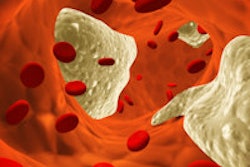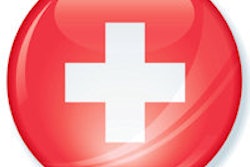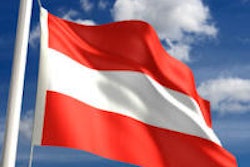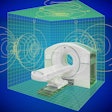
Twins can share more than blue eyes, left-handedness, and a sunny disposition, it seems. They also share body mass index (BMI) traits and atherosclerotic plaque characteristics, according to a new Hungarian study of twins that sought to eliminate environmental variations and hone in on genetics and heritability.
 Dr. Pál Maurovich-Horvat from Semmelweis University in Budapest.
Dr. Pál Maurovich-Horvat from Semmelweis University in Budapest.In the ongoing prospective study that has examined, so far, 16 pairs of monozygotic twins (MZ) and 30 pairs of dizygotic (DZ) twins, researchers found that plaque burden, plaque volume, and necrotic core volume were even more heritable than BMI.
Atherosclerosis, "the leading cause of morbidity and mortality in developing nations ... is the result of complex interactions in genetic and environmental factors," Dr. Pál Maurovich-Horvat told delegates at this month's ECR 2014. Noninvasive plaque characterization and quantification have been shown to be strong and reproducible methods of predicting who will suffer from acute coronary syndromes, said Maurovich-Horvat, from Semmelweis University's Heart and Vascular Center in Budapest.
What's not known is which part of the disease is heritable and which part is more the result of environmental factors. Neither the heritability of coronary anatomy, which might influence plaque formation through local hemodynamic effects, nor the heritability of plaque morphology has been studied, he said.
Ideal for studying heritability
Twins can provide a unique way to sort things out, Maurovich-Horvat said, because they permit researchers to assess the phenotypic impacts of environmental and genetic factors by comparing the traits of MZ and DZ twins.
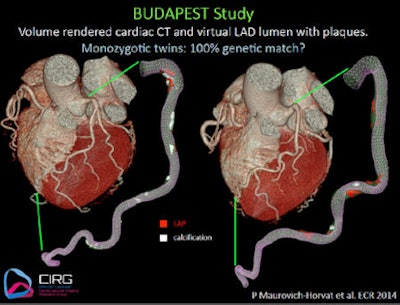 The hearts of identical twins are morphologically similar but show differences in morphology and geometry. All images courtesy of Dr. Pál Maurovich-Horvat.
The hearts of identical twins are morphologically similar but show differences in morphology and geometry. All images courtesy of Dr. Pál Maurovich-Horvat.The Burden of Atherosclerotic Plaques in Twins (BUDAPEST) study by Maurovich-Horvat and Drs. Ádám Jermendy, Tamás Horváth, Eszter Nagy, Ádám Tárnoki, and colleagues aims to examine 100 MZ and 100 DZ pairs of twins, including men older than 25 and women 40 years and older. They measured percentage of plaque burden, plaque volume, and noncalcified plaque volume using 256-detector-row coronary CT angiography (iCT, Philips Healthare).
Plaque analysis was performed using dedicated software (QAngio CT Research Edition, Medis Medical Imaging Systems); in another study Maurovich-Horvat presented during the same ECR session, this technique was shown to be accurate and highly reproducible, with a correlation coefficient of 0.961 between two observers.
"To assess the genetic influence on phenotypes, first we have to compare the phenotype variances between the siblings of monozygotic twins and digizotic twin siblings," Maurovich-Horvat explained.
The phenotypic variance in traits can be represented by the overlap between the characteristics of twin A and twin B, he said. It is defined in this study by the correlation coefficients r MZ for monozygotic twins and r DZ for dizygotic twins.
"We can expect a smaller overlap [in DZ twins] based on the fact that they share only 50% of their genome, and MZ twins share 100% of their genome -- so that basically increases the correlation coefficients," he said. What are the causes for similarities other than genetic information?
Common environmental factors that decrease similarities are the epigenetic effect, unique environment, and measurement errors, Maurovich-Horvat said. Finally, heritability can be estimated based on differences in the correlation values for different kinds of twins. If there is a high correlation in MZ twins and a smaller one in DZ twins, that means a factor has strong genetic effects.
So far the study has recruited 70 twins, including 16 MZ pairs and 20 DZ pairs. The mean age of the participants is 57 years, with dyslipidemia in about half, hypertension in one-fourth, diabetes in 10%, and smoking in about one-third.
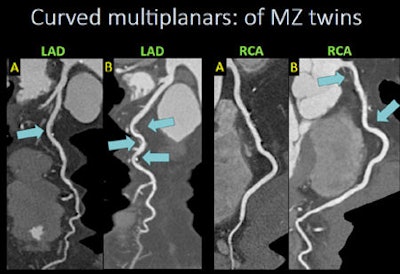 Differences can be seen in the vessel shapes and the plaque burden of monozygotic twins. In multiplanar images above, both twins have plaque, but twin B has three high-risk plaques in the left anterior descending artery that are not present in twin A. Twin B has another high-risk plaque in the right coronary artery.
Differences can be seen in the vessel shapes and the plaque burden of monozygotic twins. In multiplanar images above, both twins have plaque, but twin B has three high-risk plaques in the left anterior descending artery that are not present in twin A. Twin B has another high-risk plaque in the right coronary artery.Heritable BMI, plaque characteristics
The results showed strong heritability for BMI and even stronger values for plaque burden, plaque volume, and necrotic core volume, particularly in MZ twins sharing 100% of a unique genome, Maurovich-Horvat said. Even so, vessels showed wide variation in curvature, and plaque differences were notable throughout, especially between twins with different lifestyles, he said.
| Plaque quantification and heritability of traits | |||||||
| Monozygotic twins (MZ; n = 16 pairs) | Dizygotic twins (DZ; n = 20 pairs) | ||||||
| Mean | SD | Mean | SD | r MZ | r DZ | Heritability | |
| Age (years) | 56 | 9.3 | 60 | 7.6 | |||
| BMI (kg/m2) | 24.5 | 4.3 | 28.3 | 6.5 | 0.82 | 0.68 | 0.53 |
| Presence of plaque | 4/16 | 8/20 | |||||
| Plaque burden (%) | 43 | 37 | 0.76 | 0.45 | 0.79 | ||
| Plaque volume (mm3) | 367.8 | 424.5 | 2284.4 | 0.1 | 0.95 | 0.54 | 0.91 |
| Necrotic core volume (mm3) | 41.7 | 54.7 | 8.6 | 20.5 | 0.99 | 0.32 | 1.16 |
"BMI has pretty strong heritability, and the r value for monozygotic twins was higher for BMI than dizygotic twins, which was not surprising; then again the r MZs were higher for plaques than r DZs, and we found that plaque burden and plaque volume, actually core volume, had a higher heritability than BMI," Maurovich-Horvat said.
The early results of this study show that plaque burden, plaque volume, and low-attenuation plaque volume demonstrate strong heritability -- even stronger than BMI, he said. "Based on our data, we did not see monozygotic twins with discordant characteristics [which] also further supports this finding," he said, adding that higher numbers of twins are needed in order to improve the statistical power of the study.
Going forward, the group plans to study functional differences between the hearts of twins.




